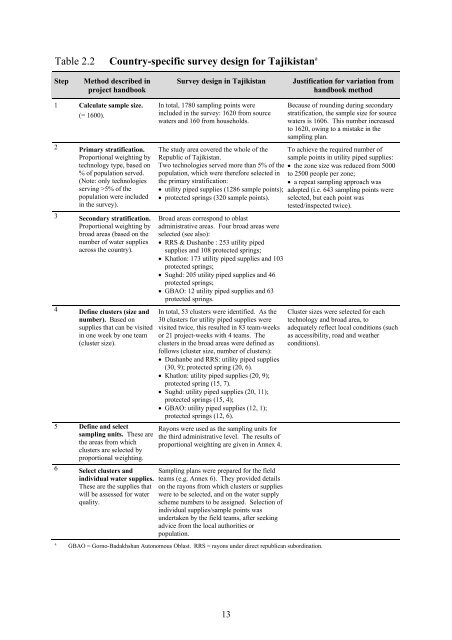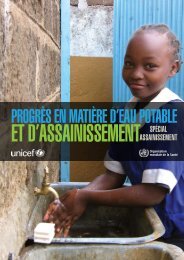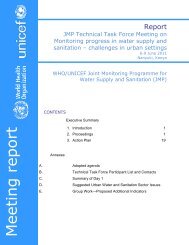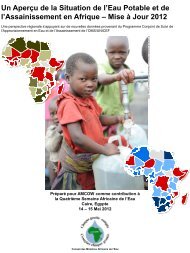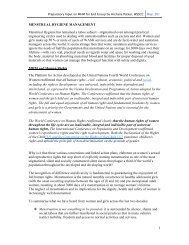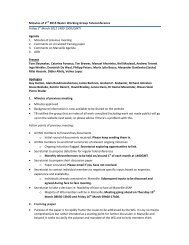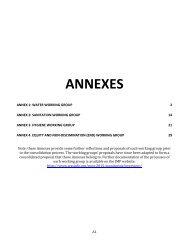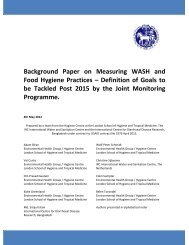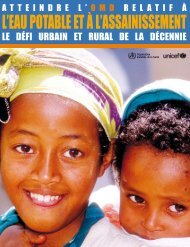rapid assessment of drinking-water quality in the republic of tajikistan
rapid assessment of drinking-water quality in the republic of tajikistan
rapid assessment of drinking-water quality in the republic of tajikistan
Create successful ePaper yourself
Turn your PDF publications into a flip-book with our unique Google optimized e-Paper software.
Table 2.2<br />
Country-specific survey design for Tajikistan a<br />
Step<br />
Method described <strong>in</strong><br />
project handbook<br />
Survey design <strong>in</strong> Tajikistan<br />
Justification for variation from<br />
handbook method<br />
1 Calculate sample size.<br />
(= 1600).<br />
In total, 1780 sampl<strong>in</strong>g po<strong>in</strong>ts were<br />
<strong>in</strong>cluded <strong>in</strong> <strong>the</strong> survey: 1620 from source<br />
<strong>water</strong>s and 160 from households.<br />
Because <strong>of</strong> round<strong>in</strong>g dur<strong>in</strong>g secondary<br />
stratification, <strong>the</strong> sample size for source<br />
<strong>water</strong>s is 1606. This number <strong>in</strong>creased<br />
to 1620, ow<strong>in</strong>g to a mistake <strong>in</strong> <strong>the</strong><br />
sampl<strong>in</strong>g plan.<br />
2 Primary stratification.<br />
Proportional weight<strong>in</strong>g by<br />
technology type, based on<br />
% <strong>of</strong> population served.<br />
(Note: only technologies<br />
serv<strong>in</strong>g >5% <strong>of</strong> <strong>the</strong><br />
population were <strong>in</strong>cluded<br />
<strong>in</strong> <strong>the</strong> survey).<br />
3 Secondary stratification.<br />
Proportional weight<strong>in</strong>g by<br />
broad areas (based on <strong>the</strong><br />
number <strong>of</strong> <strong>water</strong> supplies<br />
across <strong>the</strong> country).<br />
The study area covered <strong>the</strong> whole <strong>of</strong> <strong>the</strong><br />
Republic <strong>of</strong> Tajikistan.<br />
Two technologies served more than 5% <strong>of</strong> <strong>the</strong><br />
population, which were <strong>the</strong>refore selected <strong>in</strong><br />
<strong>the</strong> primary stratification:<br />
utility piped supplies (1286 sample po<strong>in</strong>ts);<br />
protected spr<strong>in</strong>gs (320 sample po<strong>in</strong>ts).<br />
Broad areas correspond to oblast<br />
adm<strong>in</strong>istrative areas. Four broad areas were<br />
selected (see also):<br />
RRS & Dushanbe : 253 utility piped<br />
supplies and 108 protected spr<strong>in</strong>gs;<br />
Khatlon: 173 utility piped supplies and 103<br />
protected spr<strong>in</strong>gs;<br />
Sughd: 205 utility piped supplies and 46<br />
protected spr<strong>in</strong>gs;<br />
GBAO: 12 utility piped supplies and 63<br />
protected spr<strong>in</strong>gs.<br />
To achieve <strong>the</strong> required number <strong>of</strong><br />
sample po<strong>in</strong>ts <strong>in</strong> utility piped supplies:<br />
<strong>the</strong> zone size was reduced from 5000<br />
to 2500 people per zone;<br />
a repeat sampl<strong>in</strong>g approach was<br />
adopted (i.e. 643 sampl<strong>in</strong>g po<strong>in</strong>ts were<br />
selected, but each po<strong>in</strong>t was<br />
tested/<strong>in</strong>spected twice).<br />
4 Def<strong>in</strong>e clusters (size and<br />
number). Based on<br />
supplies that can be visited<br />
<strong>in</strong> one week by one team<br />
(cluster size).<br />
5 Def<strong>in</strong>e and select<br />
sampl<strong>in</strong>g units. These are<br />
<strong>the</strong> areas from which<br />
clusters are selected by<br />
proportional weight<strong>in</strong>g.<br />
6 Select clusters and<br />
<strong>in</strong>dividual <strong>water</strong> supplies.<br />
These are <strong>the</strong> supplies that<br />
will be assessed for <strong>water</strong><br />
<strong>quality</strong>.<br />
In total, 53 clusters were identified. As <strong>the</strong><br />
30 clusters for utility piped supplies were<br />
visited twice, this resulted <strong>in</strong> 83 team-weeks<br />
or 21 project-weeks with 4 teams. The<br />
clusters <strong>in</strong> <strong>the</strong> broad areas were def<strong>in</strong>ed as<br />
follows (cluster size, number <strong>of</strong> clusters):<br />
Dushanbe and RRS: utility piped supplies<br />
(30, 9); protected spr<strong>in</strong>g (20, 6).<br />
Khatlon: utility piped supplies (20, 9);<br />
protected spr<strong>in</strong>g (15, 7).<br />
Sughd: utility piped supplies (20, 11);<br />
protected spr<strong>in</strong>gs (15, 4);<br />
GBAO: utility piped supplies (12, 1);<br />
protected spr<strong>in</strong>gs (12, 6).<br />
Rayons were used as <strong>the</strong> sampl<strong>in</strong>g units for<br />
<strong>the</strong> third adm<strong>in</strong>istrative level. The results <strong>of</strong><br />
proportional weight<strong>in</strong>g are given <strong>in</strong> Annex 4.<br />
Sampl<strong>in</strong>g plans were prepared for <strong>the</strong> field<br />
teams (e.g. Annex 6). They provided details<br />
on <strong>the</strong> rayons from which clusters or supplies<br />
were to be selected, and on <strong>the</strong> <strong>water</strong> supply<br />
scheme numbers to be assigned. Selection <strong>of</strong><br />
<strong>in</strong>dividual supplies/sample po<strong>in</strong>ts was<br />
undertaken by <strong>the</strong> field teams, after seek<strong>in</strong>g<br />
advice from <strong>the</strong> local authorities or<br />
population.<br />
Cluster sizes were selected for each<br />
technology and broad area, to<br />
adequately reflect local conditions (such<br />
as accessibility, road and wea<strong>the</strong>r<br />
conditions).<br />
a<br />
GBAO = Gorno-Badakhshan Autonomous Oblast. RRS = rayons under direct <strong>republic</strong>an subord<strong>in</strong>ation.<br />
13


